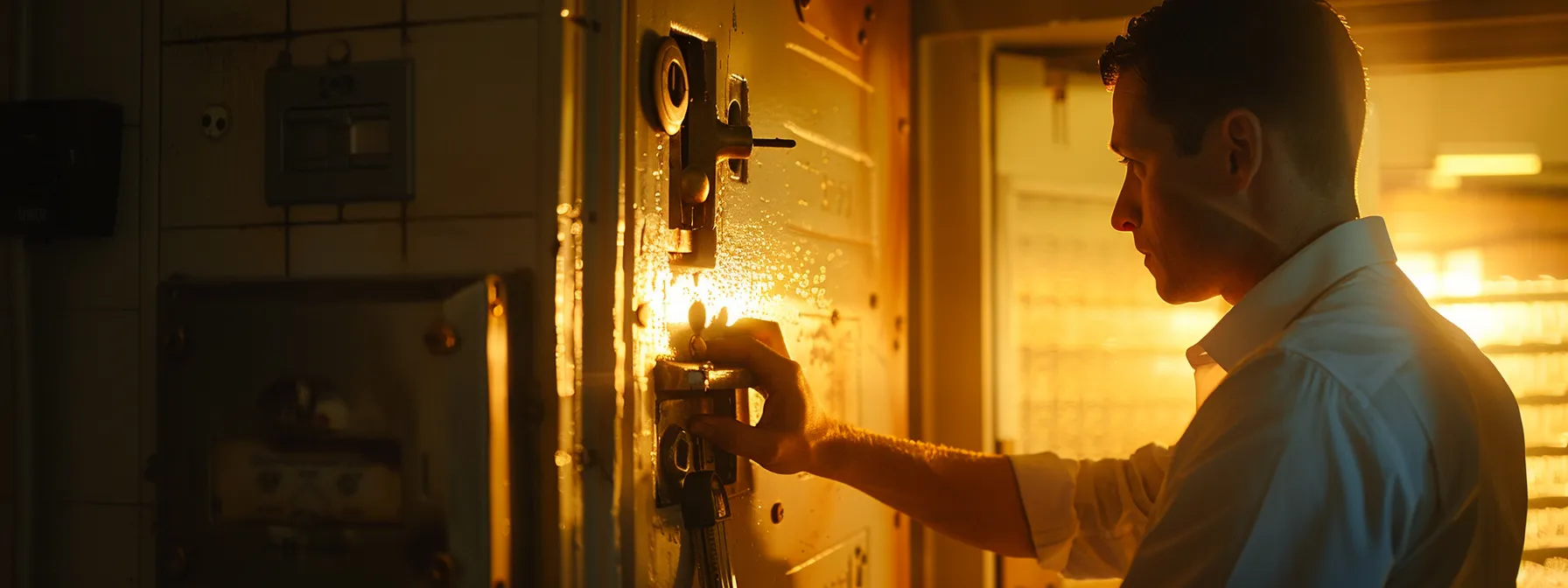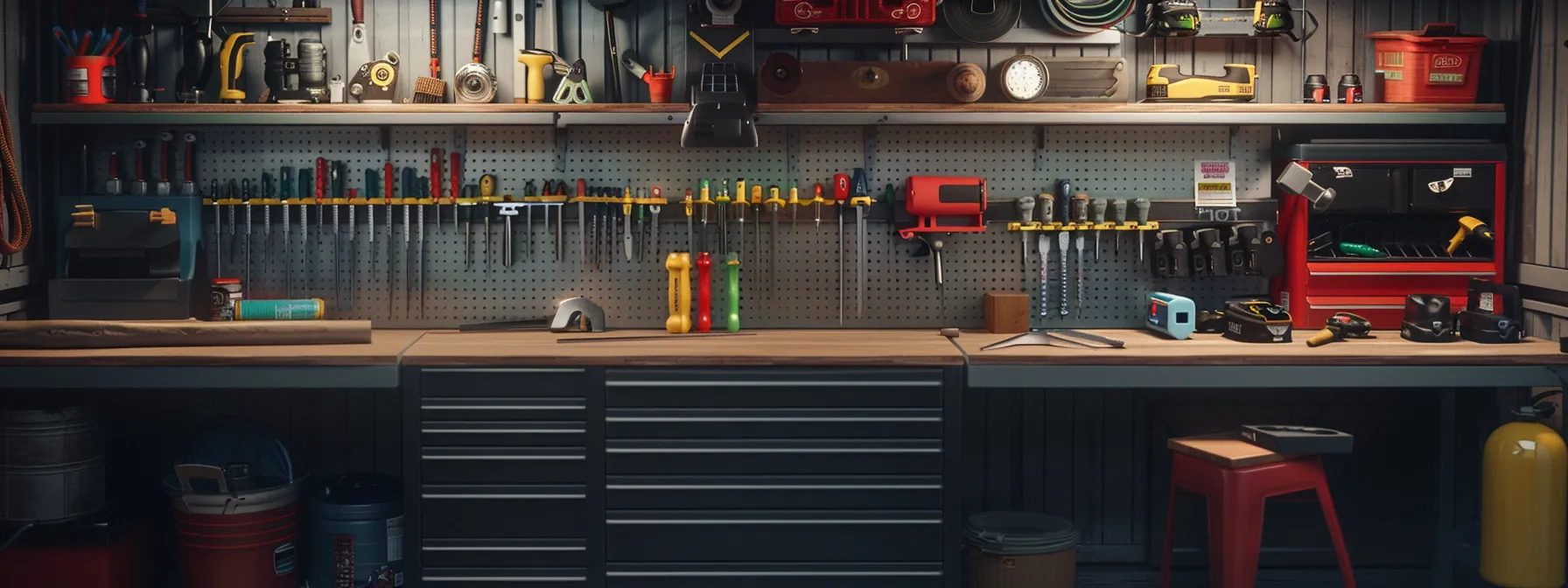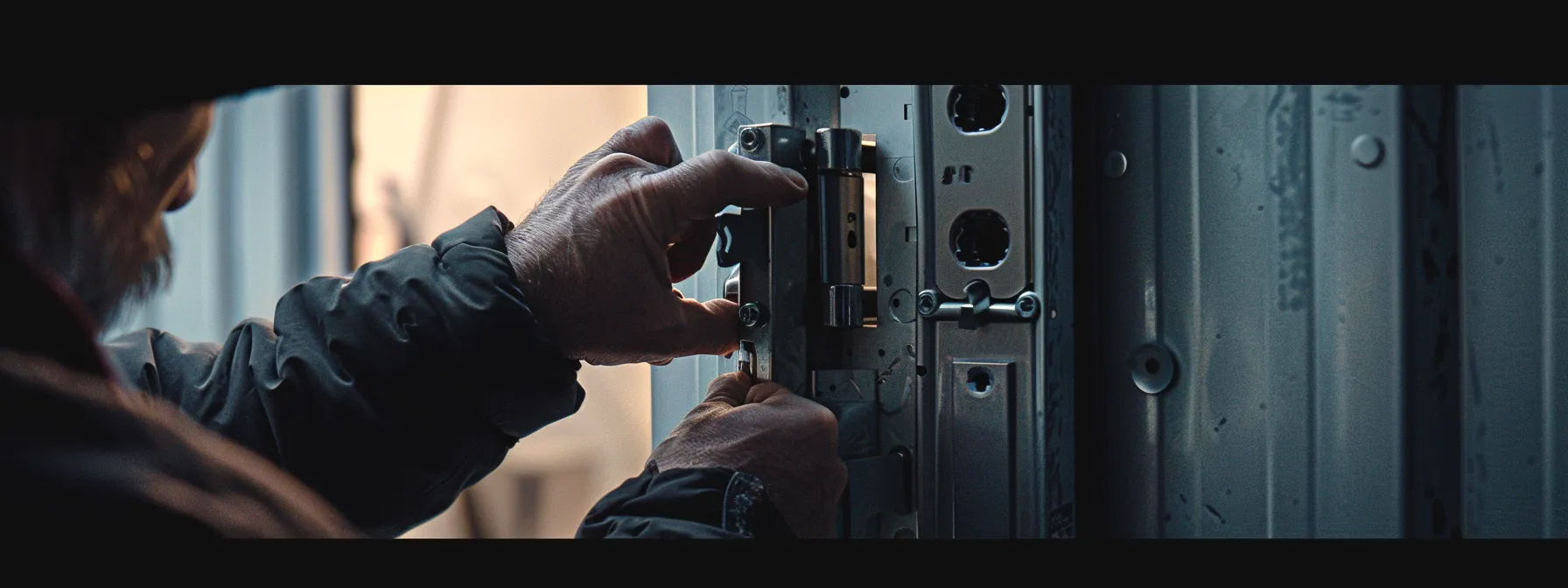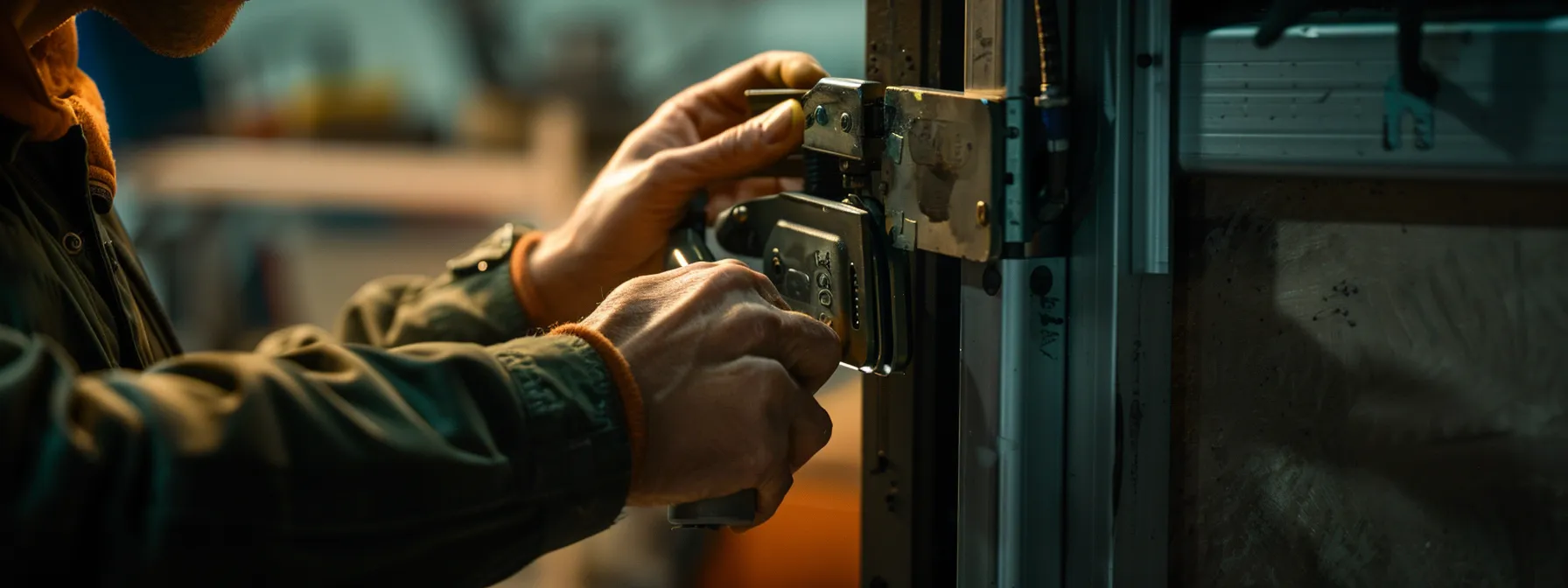
Is your commercial door failing to close properly, leaving your business vulnerable to physical security risks? In the United States, a well-functioning commercial door is a critical component of your business’s safety and security. This comprehensive guide delivers practical tips and solutions, equipping you with the knowledge to tackle common door issues, from alignment frustrations to hardware malfunctions. Readers will gain valuable insights into essential tools and maintenance practices that ensure lasting operation. By applying locksmithing expertise, particularly with trusted brands like Schlage, you’ll be equipped to address your door’s vulnerabilities and maintain its integrity. Dive into this article to secure your premises and mitigate risk with confidence.
Key Takeaways
- Regular maintenance schedules prevent costly repairs and extend commercial door lifespans
- Proper training on door usage reduces strain on mechanisms, ensuring integrity and safety
- Immediate issue reporting helps avoid exacerbation and ensures consistent door functionality
- Safety protocols and protective gear are essential for preventing accidents during door repairs
- Rigorous final testing confirms repair quality and reliability of commercial doors for users
How to Identify Common Commercial Door Problems

When a commercial door locksmith tackles door malfunctions, a systematic approach is critical. Start with a visual inspection to spot wear and damage that often escape a cursory glance. Testing the door’s operation can reveal misalignment, while a closer look at hardware components may uncover faults that compromise security. It’s essential to evaluate seals and weatherproofing to prevent environmental damage. Security features require scrutiny to thwart burglary attempts, and automation systems must be checked to ensure they consistently meet the demands of customers in Queens and beyond. This preliminary evaluation is the professional’s first step in delivering comprehensive lock service.
Perform Visual Inspection for Wear and Damage
In the domain of commercial building maintenance, a locksmith for business premises meticulously assesses the integrity of emergency exits by conducting a visual inspection to identify wear and damage. This crucial evaluation is not only required for the longevity of the doors themselves but also to uphold stringent safety regulations. Close scrutiny can reveal degradation in electronic access control systems or issues with the door’s structure, which directly impacts both security and customer service. The discovery of these conditions prompts swift remedial actions, ensuring businesses quickly return to seamless operation and reliable security standards.
Test Door Operation to Detect Alignment Issues
The operation of a commercial door can signal alignment issues which, if unaddressed, may lead to a need for extensive commercial door repair or even replacement. During the process of testing, if the door exhibits resistance, fails to close properly, or creates unusual sound, these are indications that the alignment is compromised. This misalignment can affect the function of an electric strike, hinder the efficiency of commercial keypad door lock installation, and necessitate rekeying due to damage from uneven locking mechanisms. A professional with firsthand expertise will recognize these signs and provide critical information to guide businesses towards an effective solution.
Assessing door alignment involves inspecting the following components:
- Verification of the door’s level and plumb to ensure it hangs correctly within its frame.
- Inspection of hinges and strike plates for signs of wear or misplacement that could indicate alignment problems.
- Examination of closing mechanisms, such as electric strikes, for proper alignment and function.
Inspect Hardware Components for Faults
In assessing the robustness of commercial doors, one must not overlook the hardware components which are often the linchpins of door security. A locksmith for business doors, with a vigilant eye, probes for faults in locks, panic bars, and hinges that leave premises vulnerable to theft. Should these essential pieces malfunction, not only is the security compromised, but it could also necessitate an urgent call for emergency service. Engaging a commercial locksmith service that excels in smart lock technology ensures timely and proficient restoration of security, mitigating potential threats and maintaining an impenetrable business facade. This service goes beyond mere maintenance; it is a critical assurance against business interruption.
Check Seals and Weatherstripping for Gaps
Seals and weatherstripping are crucial elements for maintaining the integrity of a commercial door, often dismissed until a breach occurs. A thorough inspection by a business locksmith, particularly in the Greater Houston area’s harsh weather, can reveal gaps that permit air and moisture penetration, potentially causing structural damage and energy inefficiency. The technology involved in high-quality commercial door lock replacement extends beyond the lock itself, including the enhancement of seals and weatherstripping. The expertise that locksmith commercial services provide is imperative, ensuring that all defense mechanisms against environmental challenges are intact and operational, thereby extending the lifespan and functionality of business entryways.
Evaluate Security Features for Malfunctions
Evaluating security features for malfunctions forms a critical aspect of commercial door maintenance. Faults in a door closer, whether it’s hydraulic or mechanical, can jeopardize the door’s ability to control ingress and egress effectively. Furthermore, damage or failure in lock and key mechanisms compromises not only the accessibility but also the safekeeping of assets within the premises. A professional inspection should include an assessment of the integrity and functionality of all aluminium door frames, padlocks, and associated security hardware to ensure the safety and security of a commercial space.
Assess Automation Systems for Operational Errors
In the bustling streets of Washington, where timely deliveries and consistent movement are crucial, the last thing a business needs is a door malfunction impeding the flow of goods or services. Business locksmiths often encounter operational errors in automation systems that can severely disrupt a company’s logistics, especially if a vehicle such as a semi-truck is trapped due to a faulty automatic door. Skilled in lock picking and adept at resolving intricate electronic malfunctions, locksmiths possess the tools and expertise required to swiftly diagnose and repair such issues, restoring the seamless operation that businesses rely on.
Essential Tools and Materials for Commercial Door Repair

Mastery in commercial door repair hinges on having the right tools and materials to ensure security and successful outcomes. Before one embarks on tasks involving commercial door installation or repair, it’s imperative to gather essential hand tools and acquire high-quality replacement parts and hardware components. Appropriate safety equipment is non-negotiable for risk mitigation. Additionally, keeping lubricants and cleaning supplies at hand aids in maintaining door mechanisms. To ensure efficiency, a safe and well-organized work area is vital, just as it is critical that all materials satisfy commercial standards. The following topics will present a thorough audit of what is required for effective door installation and maintenance.
Gather Necessary Hand Tools for Repair Tasks
The cornerstone of any property maintenance is an adept door installation and repair, calling for a selection of essential hand tools at an emergency locksmith’s disposal. From the intricate needs of semi truck locksmith services to the fine-tuning of an intercom system, the correct hand tools not just facilitate the job but assure a higher standard of workmanship. This armory should include screwdrivers, wrenches, drills, and a lock pick set, which are indispensable for addressing the most common commercial door issues efficiently and effectively.
- Screwdrivers of various sizes and heads for disassembling and reassembling door hardware.
- Wrench set to adjust and secure bolts and nuts in door mechanisms.
- Power drill for creating precise openings in door installations or facilitating lock replacement.
- Lock pick set, providing an emergency locksmith the means to address lockouts without damage.
Acquire Replacement Parts and Hardware Components
Securing the requisite replacement parts and hardware components is a foundational step in commercial door repair that 2Quick Garage Doors Woodlands takes seriously. The firm’s experts source high-quality materials, whether it’s robust steel parts for heavy-duty doors, tempered glass panels for storefronts, or components for sophisticated access control and security systems. This access to a diverse inventory, including specialized items like filing cabinet locks, empowers them to provide rapid and effective solutions to the broad spectrum of issues that commercial clients face, reinforcing their commitment to maintaining secure and fully functional business entrances.
Prepare and Wear Appropriate Safety Equipment
When undertaking the precise task of repairing commercial doors, from storefront locks to heavy-duty metal entrances, the proper preparation of safety equipment is imperative. A commercial door locksmith must prioritize safety and budget while performing inspections, donning gear such as safety glasses, gloves, and ear protection to safeguard against potential hazards. It’s this attention to detail and prioritization of workplace safety that distinguishes a professional, especially when seeking a ‘commercial door locksmith near me’. Investing in quality safety equipment is not only vital for protection but also demonstrates a commitment to upholding the highest standards of service and care in the field.
Collect Lubricants and Cleaning Supplies
The essential maintenance of commercial doors often hinges on the effective use of lubricants and cleaning supplies. Lubrication is crucial for preserving the longevity of moving parts, particularly in emergency exit devices, card readers and mechanisms within smart lock installations. In bustling urban centers like New York City, the accumulation of grit and grime is inevitable, making regular cleaning essential to maintain smart key systems’ responsiveness and integrity. With targeted application, these supplies not only ensure smooth operation but also extend the service life of door components, driving down repair needs over time.
Incorporating high-grade lubricants and cleaning agents into the repertoire of tools for door maintenance achieves optimal results:
- Silicone-based lubricants tailored for door hinges and locks to ensure they function smoothly under continuous use.
- Electrical contact cleaners for card reader terminals to maintain faultless scanning and access control.
- Disinfectant sprays suitable for smart keypads, protecting against wear and tear while ensuring hygiene standards are met.
Set Up a Safe and Efficient Work Area
Ensuring a safe and efficient work area is paramount for locksmiths in Baltimore executing lock installations and door repairs. The space must be clear of obstructions, well-lit to identify subtle defects, and possibly monitored by a camera to maintain security protocols during vulnerable moments when doors are dismantled. Locksmith professionals understand that a well-organized environment minimizes risks and enables them to deliver swift, dependable service to their clients. It is these practices in workplace preparation that contribute to the locksmith’s reputation for reliability and meticulous care.
Ensure Materials Meet Commercial Standards
In the realm of commercial door repair, assurance that all materials conform to commercial standards is non-negotiable. A professional must select crash bars, access control systems, and other security components that not only offer advanced accessibility but also comply with fire safety regulations. These access control solutions must reliably secure premises while ensuring swift egress in emergencies. The integrity of materials guarantees the safe operation of doors, shielding businesses from liability and enhancing the security of those within the establishment.
| Component | Standard | Importance |
|---|---|---|
| Access Control System | ANSI/BHMA A156.23 | Ensures electronic locking mechanisms meet industry reliability and security benchmarks. |
| Crash Bar | ANSI/BHMA A156.3 | Compliance is required for life safety in emergency evacuations and fire code adherence. |
| Door Hardware | ANSI/BHMA Series 100 | Verification that door locks and closers operate effectively under rigorous usage. |
Step-by-Step Guide to Fixing Door Alignment Issues

A commercial locksmith understands that precise door alignment is essential to the seamless operation of any business, and addressing misalignment is a key aspect of door maintenance. This segment of the guide offers a practical walkthrough, beginning with the loosening of hinges for accurate realignment, and proceeding with adjustments to the door frame for correction of misalignment. It then covers the importance of securing hinges post-adjustment, ensuring smooth door operation through testing, the application of lubricants for ongoing maintenance, and concluding with the verification of door seals and weatherstripping. Each step is designed to restore optimal function and security, a service businesses within any zip code, using electronic lock systems or traditional mechanisms, find indispensable. Whether a medeco lock requires attention or a replacement part is needed, this guide empowers professionals to tackle these challenges with confidence.
Loosen Hinges to Realign the Door Accurately
To realign a commercial door accurately, one begins by carefully loosening the hinges, a method that requires precision to avoid compromising the door’s security and functionality. This step is particularly critical for fire doors, where alignment impacts not only the door’s closing mechanism but also its integrity in preventing the spread of smoke and fire. Adjusting the hinges allows for the keypad and latch to align properly, which is essential for maintaining an effective audit trail within commercial security systems. The careful realignment ensures the door operates smoothly, bolstering the security and safety for any commercial establishment.
Adjust Door Frame to Correct Misalignment
Correcting misalignment of a commercial door requires precise adjustment to the door frame. In bustling metropolitan areas like Brooklyn, where security and quick incident response are paramount, commercial locksmith services frequently recalibrate door frames to rectify alignment. Such an alignment is vital for the seamless functioning of panic hardware and access control systems, ensuring that in times of emergency or high stress, doors operate as intended. Moreover, optimal door alignment assists in maintaining the integrity of surveillance setups by ensuring unobstructed views and clear exit pathways. The process must be executed with meticulous care to uphold the stringent security measures essential in commercial premises.
| Step | Action | Purpose |
|---|---|---|
| 1 | Inspect frame alignment | Identify the root of misalignment to inform adjustments. |
| 2 | Make incremental adjustments | Realign the door within its frame without compromising security. |
| 3 | Test door function | Ensure the door engages with panic hardware and access control systems correctly. |
Secure Hinges After Alignment Adjustments
Once the door alignment adjustments are made, securing the hinges ensures the door remains functional, and safety protocols are not compromised. This is a critical step, especially if the door operates with a mortise lock or interchangeable core system, which can be sensitive to misalignment. For businesses experiencing a lockout or those in need of a “locksmith commercial near me”, ensuring that car key remotes and electronic access devices work in tandem with properly aligned doors is paramount. The locksmith’s skill in securing hinges after realignment can prevent future alignment issues and maintain the integrity of the door’s security mechanisms.
The following steps are essential in the process of securing hinges after alignment adjustments:
- Verify that each hinge is tightened to the frame and door, ensuring there is no movement that can cause misalignment.
- Test the door’s operation with the aligned hinges to confirm that the door and lock mechanisms function smoothly.
- Recheck the door’s alignment with the frame, ensuring that the door closes and locks accurately, confirming the security of the interchangeable core or mortise lock system.
Test Door Movement to Ensure Smooth Operation
Testing door movement is a crucial final step in the alignment process, ensuring smooth and efficient operation for daily use. When a lever or deadbolt does not engage smoothly, it suggests further adjustment may be necessary. Pursuing Commercial Lock Services for detailed guidance can ensure that misaligned doors do not become a recurring issue for businesses, resulting in hassle-free locking and unlocking critical for security and customer satisfaction.
Apply Lubricant to Hinges and Moving Parts
Following the alignment, applying lubricant to the hinges and moving parts of a commercial door is pivotal in maintaining its smooth operation. A professional locksmith knows that a well-chosen lubricant can prevent the squeaks and stiffness associated with frequent use, while also guarding against the rust and wear that compromises security over time. Experts recommend using a silicone or lithium-based lubricant, which provides long-lasting protection without attracting dirt and debris, thereby ensuring the commercial door continues to serve its essential role in business operations effectively.
Utilizing lubricants correctly enhances door performance and longevity:
| Part | Lubricant Type | Frequency of Application |
|---|---|---|
| Hinges | Silicone-based | Every 6 months |
| Lock Mechanism | Graphite powder or Teflon-based | Annually or as needed |
| Rollers | Lithium-based grease | Every 6-12 months |
Verify Door Seals and Weatherstripping Alignment
The integrity of door seals and weatherstripping is crucial for both energy efficiency and protection from the elements. A thorough verification ensures that these components are properly aligned and intact, without gaps or tears that could undermine the premises’ safety and climate control. The professional scrutiny of these factors not only enhances the commercial door’s performance but also contributes to lowered energy costs and an optimized environment for business operations.
Repairing Door Hardware Components for Smooth Operation

Ensuring smooth operation of commercial doors involves meticulous attention to hardware components. Replacing worn-out handles and locks, installing new hinges, and addressing door closer mechanisms are fundamental steps for functionality. Additionally, this guide delves into repairing damaged push bars and panic hardware, and upgrading door security features to amplify safety. To conclude, it outlines necessary final tests on all components. Practical insights featured in the ensuing topics underscore the significance of comprehensive door hardware maintenance for commercial security.
Replace Worn-Out Door Handles and Locks
Efficient function and reliable security in commercial spaces hinge on sturdy and well-maintained door hardware. Consequently, replacing worn-out handles and locks is a pivotal task that not only revives a door’s functionality but also fortifies the establishment’s security. A commercial locksmith specialist would advise property managers on selecting high-grade, durable hardware and provide professional installation services to ensure seamless operation and compliance with safety standards.
Install New Hinges for Better Support
Installing new hinges is a crucial process for preserving the functionality and security of commercial doors. Quality hinges provide robust support and durability against the heavy usage typical in commercial settings. When a door starts to sag or becomes difficult to open and close, the replacement of old hinges with new, sturdy ones ensures the door operates smoothly, prevents unnecessary strain on the frame, and secures the premises effectively. This reinforces the business’s commitment to safety and seamless operation, addressing a common concern for facility managers and property owners alike.
Fix or Replace Faulty Door Closer Mechanisms
Repairing or replacing faulty door closer mechanisms is essential for ensuring the functional integrity of commercial doors. A maladjusted or broken closer can lead to doors slamming shut or failing to close fully, risks that compromise not only client and staff safety but can also impact energy efficiency. Rectifying these mechanisms requires careful attention; a professional locksmith brings profound expertise, determining whether adjustments to existing devices suffice or a complete replacement is warranted. By addressing this detail, they avert further wear on hinges and lock mechanisms, promoting a secure and sustainable entryway for businesses.
Understanding the specifics of door closer issues is vital for effective remediation:
| Door Closer Issue | Typical Sign | Recommended Action |
|---|---|---|
| Maladjusted Tension | Door closes too quickly or slowly | Adjust tension screws or replace closer if the adjustment fails |
| Oil Leakage | Visible fluid or door fails to close | Replace the seal or the closer to prevent further damage and ensure proper function |
| Wear and Tear | Abnormal noises or erratic door movement | Inspect and replace worn components or the entire closer for consistent operation |
Repair Damaged Push Bars and Panic Hardware
For the seamless function of emergency exits, maintenance of push bars and panic hardware is crucial. When repairing damaged emergency egress systems, a commercial door lock expert assesses the extent of wear or malfunction to determine whether a simple part replacement or a more comprehensive overhaul is needed. This approach not only revives the functionality of these vital safety components but also reaffirms the establishment’s compliance with fire and safety codes, ensuring personnel and patrons can vacate the premises promptly and safely during an emergency.
Upgrade Door Security Features for Safety
Enhancing door security features is a vital aspect of sustaining safety within commercial spaces. A robust upgrade consists of integrating advanced replacement locks, sophisticated access control systems, and reinvigorated panic hardware that collectively form a formidable line of defense against unauthorized entry and potential emergency situations. Such improvements, performed by seasoned professionals, ensure consistent reliability and adherence to the latest safety codes, offering business owners both peace of mind and fortified security.
The proper selection and installation of these features are crucial, with considerations for industry standards and the specific demands of a business’s operation:
| Security Feature | Benefit | Industry Standard |
|---|---|---|
| Replacement Locks | Provides resilience against lock picking and unauthorized access. | ANSI Grade 1 |
| Access Control Systems | Allows monitored and selective entry, enhancing premise control. | ISO/IEC 27001 |
| Panic Hardware | Ensures safe and rapid egress during emergencies. | ANSI/BHMA A156.3 |
Perform Final Tests on All Hardware Components
Concluding the repair process, a final assessment of all hardware components is imperative, simulating real-world usage to ascertain their proper function and reliability. The locksmith executes a meticulous series of checks to ensure that locks, hinges, and closure mechanisms perform optimally under everyday commercial stresses, thereby safeguarding against future malfunctions. This definitive evaluation provides business owners with the assurance that their commercial doors uphold safety standards and the necessary security to protect their assets.
Ensuring Safety When Repairing Commercial Doors

Guaranteeing safety during commercial door repairs is paramount. The following discussions will address critical protocols, from adhering to lockout/tagout safety procedures to wearing protective gear. Repairers must exercise caution when managing heavy doors, remain vigilant of pinch points, and uphold a well-maintained workspace, ensuring all movements are unimpeded. Post-repair, it’s essential to confirm the safe functionality of all door elements, a testament to a job well executed and aligned with standard safety practices.
Follow Proper Lockout/Tagout Safety Procedures
Adhering to proper lockout/tagout safety procedures is of utmost importance when performing commercial door repairs. This preventive measure protects technicians from unexpected energization or startup of door automation systems and controls accidental release of stored energy. By locking out and clearly marking the repair area, a locksmith ensures a safe working environment for themselves and those around, mitigating risks of injury during the maintenance of commercial doors. Implementing these safety protocols is fundamental in eliminating potential hazards and protecting the wellbeing of all individuals involved.
Wear Protective Gear During Repairs
During the repair of commercial doors, the use of appropriate protective gear is imperative for ensuring the safety of technicians. A professional understands the risks associated with the task and is equipped with safety glasses, durable gloves, and steel-toed boots to mitigate accidents. These precautions are essential when handling heavy door components and working with tools that could cause injury, demonstrating a commitment to safety protocols and fostering trust with clients seeking secure and efficient repair services.
Use Caution When Handling Heavy Doors
Exercising caution when managing the considerable weight of commercial doors is crucial to prevent physical injury and property damage. The heft of these doors requires a methodical approach, often necessitating a team effort for safe maneuvering and installation. Professionals adept in commercial door services use suitable equipment to ensure stability and control during transport and repairs, thereby upholding rigorous safety standards and enhancing overall site security.
Be Aware of Pinch Points and Hazards
Commercial door repair often involves navigating a landscape rife with pinch points and potential hazards. Professionals must meticulously identify and address areas where fingers and limbs could be caught or crushed—a common risk with heavy doors and their mechanisms. This awareness, coupled with strict adherence to safety practices, safeguards against accidents, ensuring a secure environment for the repair personnel and all door users.
| Safety Measure | Potential Hazard | Risk Mitigation Strategy |
|---|---|---|
| Use of door props | Heavy doors closing unexpectedly | Support and stabilise doors to eliminate movement during repairs |
| Pinch point identification | Fingers or limbs caught in door components | Label and verbalise high-risk areas to maintain caution |
| Team lifting techniques | Strain or injury from maneuvering heavy doors | Employ coordinated movements to manage heavy loads safely |
Maintain a Clear Work Area Free of Obstructions
Maintaining a clutter-free workspace is imperative for safety and efficiency in commercial door repair. It is essential for technicians to organize tools and materials, ensuring nothing impedes their movement or poses a tripping hazard. Such diligence not only expedites the repair process but also fosters a safe environment, minimizing the risk of accidents and ensuring a professional outcome.
| Safety Protocol | Area of Focus | Benefit |
|---|---|---|
| Clear access pathways | Workspace navigation | Prevents trips and falls during repairs |
| Organized tool stations | Equipment management | Ensures tools are within reach and stored safely |
| Debris removal | Workspace cleanliness | Reduces the risk of slips and maintains a professional environment |
Verify All Door Functions Safely After Repairs
Upon completion of commercial door repairs, the professional’s task extends to a meticulous verification of all door functions to ensure safe and reliable operation. This critical assessment involves testing the door’s responsiveness, security features, and emergency exit compliance, providing peace of mind that the repaired doors meet stringent safety standards and thereby protect the wellbeing of building occupants and visitors.
Tips for Maintaining Commercial Doors After Repair

Preserving the longevity and functionality of commercial doors requires diligent care following repair. Establishing regular maintenance schedules for doors, consistently cleaning and lubricating their components, and educating staff on proper usage are essential practices. Monitoring doors for signs of wear and maintaining a detailed log of upkeep can preempt further complications. Moreover, prompt attention to emerging issues helps avert extensive future damage, safeguarding the business’s investment in commercial door systems.
Establish Regular Maintenance Schedules for Doors
For commercial doors to operate reliably post-repair, establishing regular maintenance schedules is paramount. This preventive strategy involves periodic inspections, adjustments, and replacements as needed, tailored to the door’s usage, environment, and the specific materials from which it is constructed. A well-maintained door not only ensures safety and security but also extends its lifespan, reducing the likelihood of costly emergency repairs and prolonging the periods between significant service interventions.
To illustrate the importance of maintenance scheduling, consider the table below:
| Door Component | Maintenance Activity | Frequency |
|---|---|---|
| Hinges | Lubricate and tighten | Bi-Annually |
| Lock Mechanisms | Assess for wear, lubricate, and make necessary adjustments | Annually |
| Weatherstripping | Inspect for damage and replace if necessary | Annually or as needed |
| Closers and Exit Devices | Check function and force, adjust or replace as needed | Annually |
Regularly Clean and Lubricate Door Components
Regular cleaning and lubrication of commercial door components are crucial in maintaining functional, secure entrances after repairs. Expert locksmiths recommend that businesses perform routine cleaning to remove debris and dust that can compromise lock mechanisms, hinges, and closers. Application of suitable lubricants to these parts prevents corrosion, eases motion, and extends hardware lifespan, ensuring doors perform optimally and security standards remain uncompromised.
Train Staff on Proper Use of Commercial Doors
Training staff on the proper use of commercial doors is crucial for maintaining door integrity and ensuring the safety of both employees and patrons. A business that invests in this training demonstrates a commitment to prolonging the life of their door systems and preserving the security of their establishment. This education covers correct opening techniques, the importance of reporting any signs of damage immediately, and the avoidance of practices that lead to undue stress on door mechanisms.
- Correct opening techniques to reduce wear on hinges and locks.
- Immediate reporting of damage to prevent exacerbation of issues.
- Avoidance of practices that add undue stress, ensuring longevity of the door’s operation.
Monitor Doors Continuously for Signs of Wear
Continuous monitoring for signs of wear is essential in maintaining the integrity of commercial doors. Vigilant examination allows for the prompt detection of issues, such as misaligned hinges or a compromised seal, which might otherwise lead to potential security breaches and increased repair costs. The practice of consistent oversight ensures that doors remain in peak condition, offering both safety for patrons and a steadfast line of defense for businesses.
Implement a Maintenance Logging System
Implementing a maintenance logging system is a strategic approach to prolong the efficiency and safety of commercial doors. This organized record-keeping enables businesses to track repairs, schedule regular maintenance, and identify recurrent issues promptly. By documenting each service and noting the condition of door components, property managers gain valuable insights into the longevity of their investments and ensure that all commercial doors are consistently meeting security standards and operational excellence.
Address Issues Promptly to Prevent Future Damage
Timely resolution of emerging door issues is a critical step in preventing future damage to commercial door systems. Insisting on prompt attention to even the smallest sign of wear or misalignment can stave off more significant complications, preserving the safety, security, and longevity of your commercial entrances. Through swift action, businesses protect their investment in door repairs and ensure an uninterrupted flow of operations, a measure that clients and staff alike find invaluable.
Conclusion
The comprehensive guide to repairing commercial doors is a vital resource, ensuring that business owners maintain the safety, security, and smooth operation of their establishments. Regular maintenance, along with prompt attention to repairs, significantly extends the life of door systems and upholds stringent security standards. Educating staff on proper usage and implementing a detailed maintenance log are proactive measures that prevent costly future damage. This guide reinforces the importance of vigilant care and expert repair solutions as key to sustaining the integrity and functionality of commercial doors.
- By: admin" >admin
- Category: Uncategorized
- 0 Comments

